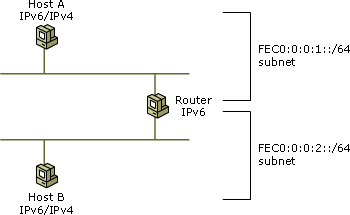 Important: Important: |
|---|
| This is retired content. This content is outdated and is no longer being maintained. It is provided as a courtesy for individuals who are still using these technologies. This content may contain URLs that were valid when originally published, but now link to sites or pages that no longer exist. |
This implementation requires three computers (two hosts and one router computer) and additional router beyond the installation of the IPv6 protocol. This implementation includes two separate network segments (also known as links or subnets), and an IPv6-capable router that connects the network segments and forwards IPv6 packets between the hosts. The following illustration shows the implementation.

By default, the IPv6 protocol for Windows CE .NET 4.1 and later configures link-local addresses for each interface that corresponds to installed network interfaces, such as Ethernet network adapters.
Link-local addresses have the prefix of FE80::/64. The link-local address of a node is the combination of the prefix FE80::/64 and the 64-bit interface identifier expressed in colon-hexadecimal notation. The interface identifier is the last 64 bits of the IPv6 address, and is derived from the 48-bit Ethernet MAC address of the network adapter. This is described in detail and examples are provided in IPv6 Interface Identifiers.
With link-local addresses, Host A and Host B can communicate with the router computer, but not with each other. In this implementation, the router advertises additional site-local prefixes. Host A and Host B use these prefixes to automatically configure site-local addresses that are derived from the 48-bit Ethernet MAC address of the network adapter. After Host A and Host B have site-local addresses, they can communicate with each other.
To obtain the interface index numbers of the two Ethernet adapters on the router computer, perform one of the following steps for each adapter:
- Type
ipconfig /all, and then pressing ENTER.
- Type
ipv6 if, and then press ENTER.
You should wait about 30 seconds for the router computer to advertise new site-local prefixes on Subnets 1 and 2, and for Hosts A and B to automatically configure site-local addresses based on these prefixes.
On Host A, type the ipconfig /allor ipv6 ifcommand to check for a new IPv6 address for the Ethernet adapter that is based on the site-local prefix. On Host B, type the ipconfig /allor ipv6 ifcommand to check for a new IPv6 address for the Ethernet adapter that is based on the site-local prefix.
On Host A, use the pingcommand and the site-local address of Host B to ping Host B. For example, if the Host B site-local address is FEC0::2:260:97FF:FE02:6EA5, the command is ping FEC0::2:260:97FF:FE02:6EA5%1.








 See Also
See Also